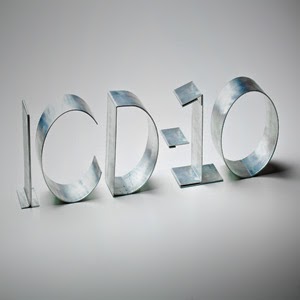ICD-10: The Saga Begins

ICD-10 News So, the changeover to ICD-10 got delayed from October 1, 2014 to October 1, 2015. And perhaps many of you are thinking, “Phew! That thing really sneaked up on us; thank goodness they’ve given us extra time.” It may be tempting to take comfort in the grace period you’ve been given. But if you stop to think about it, you’re better off getting your practice up to speed now, so you don’t have to worry about it down the line. And here’s the funny thing: ICD-10 didn’t sneak up on anybody. Truth is, the switch-over was originally scheduled for October 1, 2013 — a date that has since passed. Where would you be if that initial deadline hadn’t been delayed? Would you have been ready on time? If you aren’t sure of your answer, then you probably still aren’t set up for ICD-10… and why would you want to continue to linger in doubt? Now is the time for action, with the key benefit of time that can be better spent on building your practice. But wait, there’s more: How long do you think this ICD-10 changeover has been in the works? It wasn’t a sudden move. It may surprise you to know that the process actually began more than 30 years ago — and is based on a classification system developed by French physician Jacques Bertillon nearly a century before that. Why should providers prepare for ICD-10 in spite of the delay? Coming next week: ICD-10 Strikes Back
ICD-10 Delayed Until 2015

Author Rita Mae Brown said, “If it weren’t for the last minute, nothing would get done.” ICD-10 delayed! In the case of ICD-10, with a deadline looming mere months down the road, we were heading into a figurative “last minute” — when practices were beginning to hunker down and take the necessary steps to ready themselves for the switch from ICD-9. Now that Congress has moved the deadline from October 1, 2014 to October 1, 2015, practices may be feeling the temptation to put off further action. After all, the last minute just got delayed by a whole year, right? Don’t kid yourself. ICD-10 is a change of enormous proportions — one that cannot be avoided or ignored, and definitely not one that should be put on the back burner. The changeover will take time away from patient care, and could have a serious impact on your bottom line. The changeover adds an additional layer of complexity — essentially giving payers even more opportunity to reject claims. We’ve been working on this problem for more than a year, and are continuing to address it, in order to ensure that our clients are ready now. Our system is geared up to make the transition as painless as possible; you simply need to rip off the band-aid and commit to the process. The choice is yours: You can take Congress’ action as an excuse to put off what must be done, leading to another year of worry and hand-wringing. Or you can get yourself prepared now, and pass the time with confidence, knowing that there’ll be no last-minute hysterics, and that your claims will be backed up by a system that’s been built and programmed for your success. We will continue to offer continuing education webinars on ICD-10 delayed while keeping everyone informed about further changes and requirements. In the meantime, we encourage providers to evaluate their ICD-10 readiness and audit risk by scheduling a Practice Evaluation. Click on the link below to get started.
ICD-10 | Five Building Blocks | Q&A from Webinar

ICD-10 Questions and Answers ICD-10 is coming soon. As you get your practice ready for the ICD-9 to 10 changeover, you are bound to have questions regarding documentation and compliance. To help you get the answers you need, we have compiled all questions that were asked during our recent webinar “ICD-10 | Five Building Blocks,” along with the presenter’s responses. Feel free to add any new questions in the comment section below. Q: Where can I find CMS guidelines in written form? A: On CMS.gov, click on the Medicare link and you will find a link for both local and national coverage determinations. Q: When can I start finding ICD-10 codes within your software and submitting them? A: Our software already has all the ICD-10 codes listed; we are building the crosswalk now. We recently completed ICD-10 testing with Medicare, and were successful with our front-end edits. We are looking to have this available to practices by June, to really start testing and cross-walking. At this point, payers are not accepting claims with these new codes; they are not coming over until October 1, but we are testing with payers and clearinghouses directly. You will be able to see which ICD-9 codes correspond to the appropriate diagnosis 10 codes, side-by-side right in the travel card.
Ripe for Success

Software solution promises to be the “secret ingredient” By Kathleen Casbarro Will Ben’s new tech solution lead to the perfect outcome? “So…?” Carmen asked with an upward lilt that made it into a question, “how’s the documentation going?” “Thanks for asking,” Ben said, dropping a kiss on her nose. “I think it’s going to be good. You know I’ve been going back and forth a bit on how to approach the need for greater specificity in our documentation.” Carmen rolled her eyes. “I’d noticed. But I can see why, too. It’s hard to know exactly what you need to do and what the consequences are likely to be.” “Turns out the new software we’ve been looking at has an internal auditing process. Basically, I think we can work with the coaches to find out just how we can use our documentation to build the right ICD-10 codes, and actually try it out and see how far we are from perfection.” “And if you’re not quite perfect, you’ve got some time to work on it.” “Exactly. We’ll be able to see what practices we don’t yet have in place. We won’t be taking a shot in the dark and hoping we’re on the right track.” Mike sniffed. “Is that sauteed mushrooms I’m smelling?” “Yes. Mushroom ravioli tonight, with a fresh marinara sauce and garlic bread. Just a little good home cooking.” “Very good home cooking. Can I help?” “Come keep me company while I add a little squeeze of lemon.” Ben followed Carmen into the kitchen, where their son was already sitting at the table coloring. “I really feel like things are coming together,” he told his wife as he ruffled his son’s hair. “Just having a clear plan and a clear goal makes all the difference.” Carmen beamed.Ben held up his hands in mock protest. “Are you about to tell me some special way in which this reminds you of pizza?” “Not at all.” Carmen busied herself plating the ravioli and ladling on sauce. “I could however say that it’s like having a great recipe and setting out all the ingredients, measured and ready, before you begin to cook.” She added a slice of toasted garlic bread on each plate. “That’s the way you get a perfect outcome. It’s not that you don’t have work to do, but you have it all laid out clearly, so success is easier.” “I’ll take that,” Ben smiled. Will Dr. Ben’s new tech solution lead to the perfect outcome? Everything that we have published about ICD-10 can be found on our ICD-10 page.

